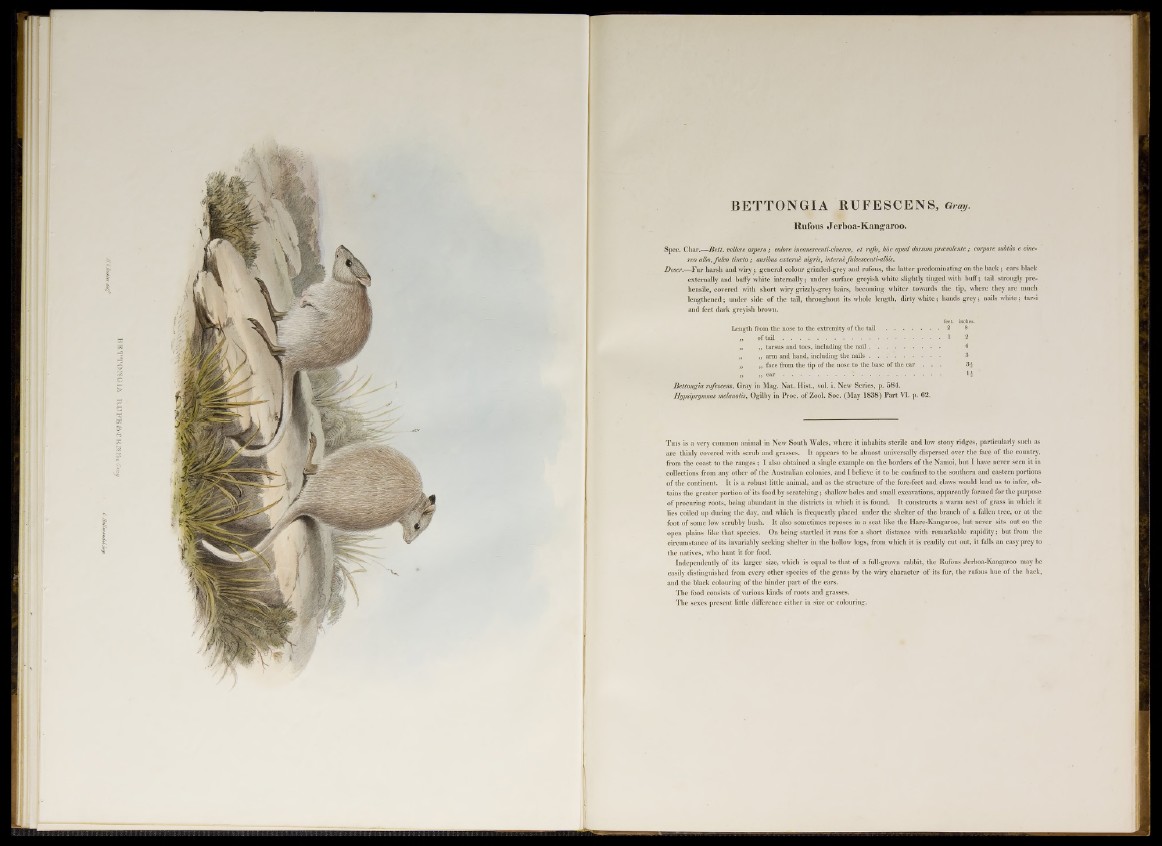
BBTTONCJIA IIMJFESCE
BETTONGIA RUFESCENS, Gray.
Rufous Jerboa-Kang,aroo.
Spec. Char.— B e tt. tellere aspero ; colore incanescenti-cinereo, et rufo, hoc apud dorsum prcemlente ; corpore sub l ies e cine-
reo albo,fulvo tine to ; auribus ext erne nigris, interne fulvescenti-albis.
Descr.—Fur harsh and wiry; general colour grizzled-grey and rufous, the latter predominating on the back; ears black
externally and bufly white internally; under surface greyish white slightly tinged with buff; tail strongly prehensile,
covered with short wiry grizzly-grey hairs, becoming whiter towards the tip, where they are much
lengthened; under side o f the tail, throughout its whole length, dirty white; hands grey; nails white; tarsi
and feet dark greyish brown.
feet, inches.
Length from the nose to the extremity of the t a i l 2 8
,, of t a i l ........................................................................................................1 2
„ „ tarsus and toes, including the n a il............................................ 6
- ,, „ arm and hand, including the nails ............................ 3
,, ,, face from the tip of the nose to the base of the ear . . . 3£
,, ,, e a r ...................................... ' . ..................................................... 14
Bettongia rufescens, Gray in Mag. Nat.. Hist., vol. i. New Series, p. 584.
Hypsiprymnus melanotis, Ogilby in Proc. of Zool. Soc. (May 1838) Part VI. p. 62.
T h i s is a very common animal in New South Wales, where it inhabits sterile and low stony ridges, particularly such as
are thinly covered with scrub and grasses. It appears to be almost universally dispersed over the face o f the country,
from the coast to the ranges; I also obtained a single example on the borders o f the Namoi, but I have never seen it in
collections from any other o f the Australian colonies, and I believe it to be confined to the southern and eastern portions
o f the continent. It is a robust little animal, and as the structure o f the fore-feet and claws would lead us to infer, obtains
the greater portion of its food by scratching; shallow holes and small excavations, apparently formed for the purpose
of procuring roots, being abundant in the districts in which it is found. It constructs a warm nest o f grass in which it
lies coiled up during the day, and which is frequently placed under the shelter o f the branch of a fallen tree, or at the
foot o f some low scrubby bush. It also sometimes reposes in a seat like the Hare-Kangaroo, but never sits out on the
open plains like that species. On being startled it runs for a short distance with remarkable rapidity; but from the
circumstance o f its invariably seeking shelter in the hollow logs, from which it is readily cut out, it falls an easy prey to
the natives, who hunt it for food.
Independently o f its larger size, which is equal to that of a full-grown rabbit, the Rufous Jerboa-Kangaroo may be
easily distinguished from every other species o f the genus by the wiry character o f its fur, the rufous hue o f the back,
and the black colouring o f the hinder part o f the ears.
The food consists o f various kinds o f roots and grasses.
The sexes present little difference either in size or colouring.